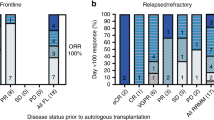Abstract
Introduction: A preliminary analysis of our double high-dose chemotherapy with stem cell rescue (HD-SCR) clinical trial for breast cancer, and preclinical cross-resistant studies, suggested that melphalan (M) adversely affected response to subsequent chemotherapy, i.e., that the sequence of alkylating agents (AAs) might affect response. We, therefore, constructed and examined preclinical models to determine whether prior exposure to M, in fact, adversely affected response to other therapy. Purpose: The purpose of the study was to determine whether the sequence of AAs, specifically the prior use of M, adversely affected response to subsequent treatment. Methods: The methods employed were the following: (1) Human tumor cell lines rendered resistant by in vitro sequential exposure to five different AAs were developed. The resistant cell lines were examined for cross-resistance to alkylating and other agents. (2) In vivo studies in the p388 mouse leukemia for resistance and cross-resistance among the AAs. (3) In vivo studies of the effect of sequence of AAs on response in mice bearing EMT6 breast cancer. (4) The double transplant model was developed in the mouse and the sequence of high-dose AAs was studied. (5) Biochemical and reverse transcriptase-polymerase chain reaction (RT-PCR) studies of the various resistant tumor cell lines. Results: (1) The in vitro human tumor cells resistant to M were cross-resistant in 57% of tests to other AAs. In contrast, resistance for other AAs crossed to other agents in only 10 to 20% of tests. (2) The in vivo studies of p388 indicated that resistance to M commonly crossed to other AAs and many non-AAs. (3) The results for the mouse breast cancer (EMT6) studies of the sequence of AAs again indicated that M employed first markedly reduced responsiveness to subsequent treatment, particularly with AAs. (4) The double transplant model: again, M first markedly reduced response to other agents. (5) The in vitro resistant human tumor cell lines, particularly the breast cancer cell line MCF7, were found to contain high concentrations of glutathione S1 transferase gamma, which is consistent with that mechanism being responsible for resistance. Conclusion: The sequence of alkylating agent treatment may substantially influence response. Melphalan, particularly, produces resistance that commonly crosses to the other AAs. Mechanistic studies indicate significant changes in glutathione S1 transferase, a known mechanism for broadly based resistance to AAs.
Similar content being viewed by others
Author information
Authors and Affiliations
Additional information
Received: 24 March 1999 / Accepted: 11 August 1999
Rights and permissions
About this article
Cite this article
Frei III, E., Ara, G., Teicher, B. et al. Double high-dose chemotherapy with stem cell rescue (HD-SCR) in patients with breast cancer – effect of sequence. Cancer Chemother Pharmacol 45, 239–246 (2000). https://doi.org/10.1007/s002800050035
Issue Date:
DOI: https://doi.org/10.1007/s002800050035




